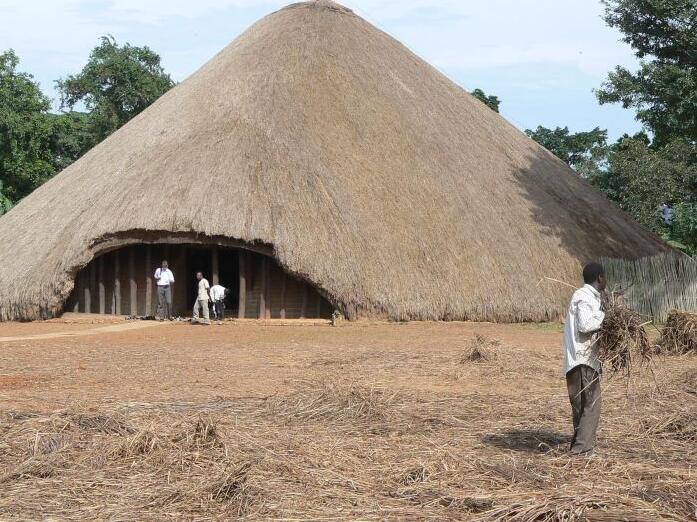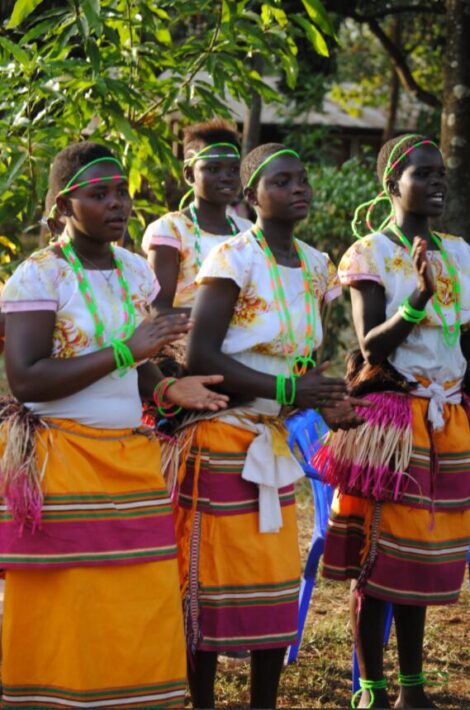Cultural identities
The different ethnic groups of Uganda show great cultural diversity. While the Bambuti and Batwa live as a threatened and discriminated minority in the west of the country, their neighbors, the Batooro organized in a kingdom, in turn, the Bakonjo and Bamba live in the Ruwenzori Mountains and are said to have emigrated from Mount Elgon. Father and son used to use wordless whistling communication when hunting.
While in some ethnic groups it is customary to circumcise young men when they enter adulthood, women are circumcised among the ethnic groups of the Sabiny in the Kapchorwa region, the Pokot and the Tepeth in Karamoja. It is not easy to combat these practices effectively unless you know the socio-cultural roots and start there. But more and more often those affected revolt and go public against the cruel ritual. After all, genital mutilation has been banned in Uganda since 2009 and there is a risk of up to 10 years imprisonment for violations. As a result, the ritual is now being carried out by some families in Kenya, hidden in corn fields, and there is no question of hygienic conditions.
A cruel ritual continues to spread: Faith healers kill children, their body parts are supposed to bring health and, above all, financial success for the customers. Uganda’s construction boom encourages cruel practice, because if a building is to be successful, children are buried under it. A special police unit has been tasked with combating the cruel practice for years, but corruption and lack of resources severely limit its work.
The traditional wedding, i.e. the negotiation of the bride price, takes place in different ways in each ethnic group. In Ankole, the brides were (and in some cases still are) fattened with milk until they were fat enough.
For over 600 years make artisans of Ngonge clan in Buganda a bark cloth, the so-called. Barkcloth, ago; formerly for the use of the royal family today also for tourist purposes. UNESCO put the rare handicraft on the list of the intangible cultural heritage of mankind.
Uganda’s museums
According to internetsailors, the Uganda Museum in Kampala was founded as early as 1908. To this day it is considered one of the main attractions of Kampala. In addition to ethnological, anthropological and many historical objects, there are also vehicles of the former presidents. The changing exhibitions are interesting. In recent years, however, many smaller cities such as B. Moroto, Kabale or Gulu developed small but sometimes very attractive community museums.
Traditional theater, music, film, art and sports
The most widespread cultural vehicle in Uganda is the theater. The Ndere Dev ‘Theater is the first cultural project to be supported by the Austrian Development Cooperation in the Ministry of Foreign Affairs.
Almost every Ugandan ethnic group has its own traditional music, instruments, dances, costumes and lyrics. Some traditional dances are already recognized as Intangible Cultural Heritage by UNESCO. The drum, also known as engoma in southwest Uganda, is widespread. Their sound body is often as big as a barrel and covered with cow skin. The xylophone is widespread in central Uganda. The Madi people in the northwest of the country, on the other hand, like to play lyrical music.
However, modern music plays a major role today. Some kids, especially in Kampala, have discovered break-dance and hip hop for themselves. One project is trying to reach marginalized young people.
Uganda’s up-and-coming film industry Wakaliwood has recently been producing action films in Kampala’s slums with the smallest budget and often pans and exhaust pipes as weapons, with a lot of blood that is no longer pig’s blood, but consists of paint.
Uganda’s international film festival Amakulu is taking place again after a break of several years, now entirely under Ugandan management. As a new target group, children are now being addressed with cartoons, because TVs are becoming more and more popular in Uganda and mainly children are sitting in front of them.
A film from Uganda “Call me Kuchu” received the development film award “Cinema fairbindet” in 2012. It has been awarded every year since 2011 by the Federal Ministry for Economic Cooperation (BMZ) in cooperation with the Berlinale. The film is about the daily difficulties homosexuals in Uganda face.
The oral tradition has played and continues to play a major role in Uganda since ancient times. In the evening, stories were told from generation to generation by the fire. Today this is still partly taking place, but formal education and modern entertainment are gaining in importance.
In the field of literature, Uganda has some great writers. Okot P’Bitek from Gulu was considered one of the most important poets in Africa. In his pieces “Song of Lawino”, “Song of Ocol” and “Two songs” he deals with the contrasts between modernity and tradition. Moses Isegawa originally wanted to become a cardinal, but eventually ended up in the Netherlands. In his work “The Snake Pit” he deals with intrigue and corruption during the Amin regime. The novel “Abyssinian Chronicle”describes a young man from his childhood to emigration to Europe, including insights into corruption, nepotism and intra-African ethnic conflicts. Jennifer Nansubuga won the Kwani? 2013 with her family saga Kintu, which begins in pre-colonial Buganda and tries to combine tradition with the modern world.
Uganda’s handicrafts are very diverse, starting with skilfully crafted roof structures, through ceramics, artfully woven mats or baskets to filigree jewelry. Pictures by Ugandan artists can be found regularly at exhibitions in the galleries in Kampala. A large number of concerts, festivals and workshops are now taking place in Kampala, but also in smaller cities.
The 19-year-old student Jan Mukuiibi became Miss Uganda 2017. One of her predecessors, Leah Kalanguka, not only had to show off her beauty, but also her agricultural skills, such as cleaning pigs or milking cows. After all, they are supposed to help market the country’s agricultural products.
Sports activities are particularly popular with Uganda’s youth. Sports and games are offered in schools. In their free time, many young people love to play football or do sports. Unfortunately, due to a lack of equipment and funding, not many succeed in making a career. Akii-Bua from Lira was Uganda’s first Olympic champion and ran the men’s 400 m hurdles in a world record time in 1972. Stephan Kiprotech from Kapchorwa only managed another victory in 2012, winning the gold medal in the marathon in London. Joshua Cheptegai won in August 2020, also from Kapchorwa, set the world record in the 5000 meter run in Monaco. In October of the same year, 19-year-old Jacob Kiplimo, also from the Mount Elgon region in the east of the country, won the world title in the half marathon.
The clothing
The first clothes in Uganda were reserved for kings. The so-called Barkcloth was and is still made from tree bark. The tree is not felled, the bark grows back. The craft is now on the list of the intangible cultural heritage of mankind. Today it is used for cultural purposes, as a funeral robe and as handicrafts.
In everyday life, clothes in Uganda are often very similar to ours. But for celebrations or in rural areas you can often find women with busuti, a wide long dress, or men with kanzu, a white robe.
But a generation of young women is growing up in the cities who are open to new but African fashion. Fashion designers like Sylvia Owori use this opportunity and combine African fabrics with modern cuts and thus reach a large audience, including jobs for local tailors.
However, Ugandan women are no longer allowed to dare to wear mini skirts: under the anti-pornography law passed in 2014, revealing clothing is prohibited.
In October 2019 it was now stipulated that civilians are not allowed to dress like soldiers. The reason for this is undoubtedly the red beret, the trademark of opposition politician Bobi Wine. The dress code of the military has now been laid down on 30 pages; civilians are not allowed to be caught with it, otherwise they face imprisonment, in the worst case life sentence.
German-Ugandan cultural relations
Uganda and Germany have a longstanding cooperation in the areas of culture, sport and education. This includes the promotion of the German language as well as the exchange in science and in higher education, among other things through the award of DAAD scholarships. German is taught as a subject at ten secondary schools and three universities. There is also a strong cooperation in the sporting field.
The Goethe Center in Kampala emerged from the Ugandan German Cultural Society in 2008 and can be found on Bukoto Street in Kamwokya. Cultural events, theater, language programs and much more are offered

